

Kolem roku 2030 by mohla začít malá doba ledová. Rekordně teplé vánoční svátky by nás neměly svádět k uložení zimníků hluboko do skříní.
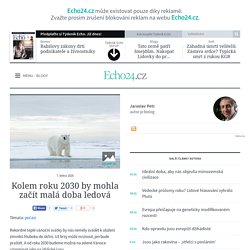
Už brzy může mrznout, jen bude praštět. A od roku 2030 budeme možná na zelené Vánoce vzpomínat jako na idylické časy. Vír nad severním pólem Bílé Vánoce jsme si mohli letos užít jen při pohledu do uměle zasněžených dekorací obchodních domů nebo na pohlednice s obrázky Josefa Lady. Místo bílé duchny pokrývající krajinu a reje vloček ve vzduchu jsme si užívali ve vánočním čase kaskádu teplotních rekordů. Atmosféru nad Arktidou roztáčí zesílený teplotní kontrast mezi horkými tropy a studenou Arktidou, která se v zimních měsících noří do polární noci a silně se ochladí. Pokud je vír kolem severního pólu silný, působí na mrazivý polární vzduch jako mantinely a nepouští jej do nižších zeměpisných šířek. Arktický cirkumpolární vír je k „zakolíbáním“ následovaným třeskutými mrazy nejnáchylnější během vrcholící zimy, když v něm vzduch cirkuluje s nejvyšší intenzitou.
2004 Science. 8693. Zapomeňte na globální oteplování, možná přichází další malá doba ledová. Zapomeňte na globální oteplování, možná přichází další malá doba ledová (Josef Zemánek 31.1.2009, aktualizováno 16.1.2011) Fenomén globálního oteplování je bezesporu klimaticko politickým tématem číslo jedna naší moderní doby.
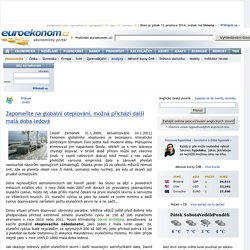
Plánujeme eliminovat jím napáchané škody, někteří se s ním dokonce chystají bojovat. V brzké době přitom může být všechno jinak. V zajetí vášnivých diskusí totiž mnozí z nás začali přehlížet varovná empirická data a zároveň přestali naslouchat názorům oponujících klimatologů. Otázka proto již za několik měsíců nemusí znít, zda se planeta oteplí více či méně, pomaleji nebo rychleji, ale kdy už skončí její prudké ochlazování. Série nejnovějších astronomických dat hovoří jasně: Na Slunci se dějí v posledních měsících zvláštní věci. Celou situaci přitom doprovází obrovský paradox.
Sluneční cykly a historické malé doby ledové Sluneční skvrny pozoruje lidstvo již od dob starověké Číny (4. století př.n.l). Co se však najednou nestane. Přichází další malá doba ledová!? 1. Malou dobu ledovou mohly způsobit mohutné sopečné erupce - Gnosis9.net. "Je to poprvé, kdy někdo jasně určil přesný začátek chladného období zvaného Malá doba ledová," prohlásil hlavní autor studie Gifford Miller z University of Colorado a odkázal na závěry studie.

Do klimatického systému několikrát v poměrně krátkém časovém rozpětí zasáhly situace s ochlazujícími účinky, v tomto případě to byly sopečné erupce, které měly kumulativní ochlazující efekt a odstartovaly sled zpětných vazeb s dlouhodobým dopadem na podnebí. Slova svého kolegy potvrdila i Bette Otto-Bliesnerová z amerického Národního centra pro výzkum atmosféry (NCAR): "Naše simulace ukázaly, že sopečné erupce měly zřejmě závažný ochlazující účinek. Human-made climate change suppresses the next ice age. Humanity has become a geological force that is able to suppress the beginning of the next ice age, a study now published in the scientific journal Nature shows.

Cracking the code of glacial inception, scientists of the Potsdam Institute for Climate Impact Research found the relation of insolation and CO2 concentration in the atmosphere to be the key criterion to explain the last eight glacial cycles in Earth history. At the same time their results illustrate that even moderate human interference with the planet's natural carbon balance might postpone the next glacial inception by 100,000 years. "Even without human-made climate change we would expect the beginning of a new ice age no earlier than in 50,000 years from now -- which makes the Holocene as the present geological epoch an unusually long period in between ice ages," explains lead author Andrey Ganopolski. The Next Ice Age. Human-made climate change suppresses the next ice age. “Even without man-made climate change we would expect the beginning of a new ice age no earlier than in 50.000 years from now – which makes the Holocene as the present geological epoch an unusually long period in between ice ages,” explains lead author Andrey Ganopolski.
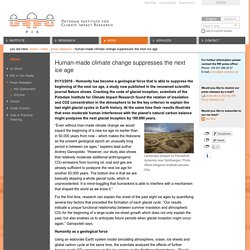
“However, our study also shows that relatively moderate additional anthropogenic CO2-emissions from burning oil, coal and gas are already sufficient to postpone the next ice age for another 50.000 years. The bottom line is that we are basically skipping a whole glacial cycle, which is unprecedented. It is mind-boggling that humankind is able to interfere with a mechanism that shaped the world as we know it.” The Little Ice Age in Europe - Influence of Dramatic Climate Shifts on European Civilizations: The Rise and Fall of the Vikings and the Little Ice Age.
Note to general public:
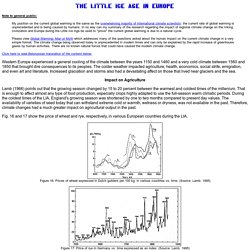
Introduction to special section on Global Warming and the Next Ice Age - Chylek - 2007 - Journal of Geophysical Research: Atmospheres (1984–2012) Ice growth in the greenhouse: A seductive paradox but unrealistic scenario. 1968IrAJ....8..153O Page 153. Future Climatic Changes: Are We Entering an Exceptionally Long Interglacial? Various experiments have been conducted using theLouvain-la-Neuve two-dimensional Northern Hemisphereclimate model (LLN 2-D NH) to simulate climate for thenext 130 kyr into the future.
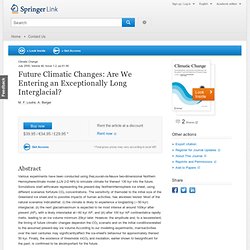
Simulations start withvalues representing the present-day NorthernHemisphere ice sheet, using different scenarios forfuture CO2 concentrations. The sensitivity of themodel to the initial size of the Greenland ice sheet,and to possible impacts of human activities, has alsobeen tested. How climate change could cause an Ice Age in Europe. So far, the progress of global warming and climate change has been relatively smooth, a gradual decline in livability marked by a gradual increase in increasingly catastrophic events.

Yes, catastrophic events — but a gradual increase in their number and degree. Key word, gradual. We assume, perhaps to comfort ourselves, that the (so far) slow and gradual decline in the livability of the planet will remain … slow and gradual. But there’s no reason to assume that there won’t be sudden collapses as well, sudden discontinuities, the way a steady dribble of small chunks of ice might fall from a Greenland glacier into the sea, then suddenly a piece the size of Ohio splits and floats away, lost, never to come back.
A discontinuity, a break from the gradual. Discontinuities work in the social sphere as well, in the sphere of confidence and panic. Here’s another discontinuity. Carbon emissions to block next ice age. It is unclear exactly how these factors influence the climate but the early seeds of change are followed by rising levels of carbon dioxide in the atmosphere as the planet warms up, and by the absorption of the gas by the sea as the Earth cools and ice sheets form.

By comparing current conditions with a similar period between ice ages 780,000 years ago, the researchers estimated that glacial inception – an early sign of an imminent ice age - should start in the near future. Extreme swings in temperature between Greenland and Antarctica suggest that this process is beginning, they said. Global Cooling: Is an Ice Age Coming? - Health & Science. COPENHAGEN, Denmark -- It wasn't supposed to happen: a ship full of scientists and environmentalists sent to the Antarctic to find melting ice from global warming got stuck in frozen ice from fearsome cold.
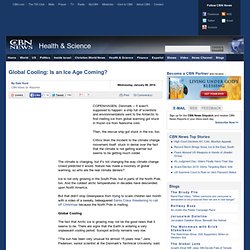
Then, the rescue ship got stuck in the ice, too. Critics liken the incident to the climate change movement itself: stuck in denial over the fact that the climate is not getting warmer but seems to be getting much colder. The climate is changing, but it's not changing the way climate change crowd predicted it would. Answers to predict the next ice age. Research team at University of Bergen keep making discoveries about how the origins of life may influence future climate predictions. This photo shows researchers working in Blombos Cave in South Africa.
(Photo: UiB/TRACSYMBOLS) The last ice age lasted from 70,000 to 10,000 years ago. For this, and other ice age periods to take place, the ice caps had to increase in volume. Global Warming or The “New Ice Age”? Fear of the “Big Freeze” Next Ice Age Delayed by Global Warming, Study Says. September 3, 2009 Humans are putting the brakes on the next ice age, according to the most extensive study to date on Arctic climate change.
The Arctic may be warmer than it's been in the past 2,000 years—a trend that is reversing a natural cooling cycle dictated by a wobble in Earth's axis. Previously, researchers had looked at Arctic temperature data that went back just 400 years. (See photos of how climate change is transforming the Arctic.) That research showed a temperature spike in the 20th century, but it was unclear whether human-caused greenhouse gas emissions or natural variability was the culprit, noted study co-author Gifford Miller of the Institute of Arctic and Alpine Research at the University of Colorado, Boulder.
By looking even farther back in time, Miller and colleagues' newest study reveals that the 20th century's abrupt warming may have in fact interrupted millennia of steady cooling. When Will the Next Ice Age Begin? By ANDREW C. REVKINPublished: November 11, 2003 The maxim ''what goes around comes around'' applies to few things more aptly than ice ages. In a rhythm attuned to regular wiggles in Earth's orbit and spin, 10 eras of spreading ice sheets and falling seas have come and gone over the last million years. Through that span, in fact, the cold spells have so dominated that geophysicists regard warm periods like the present one, called the Holocene, as the oddities.
Indeed, the scientific name for these periods -- interglacials -- reflects the exceptional nature of such times. Carbon emissions 'will defer Ice Age' 9 January 2012Last updated at 06:20 By Richard Black Environment correspondent, BBC News The climate, if not species, of an Ice Age "ought" to return within 1,500 years. Will There Be a New Ice Age? - HowStuffWorks. New data backs ‘ice age’ prediction. Text smaller Text bigger NEW YORK – As the United Nations prepares for its 2014 Climate Summit in New York this month with an agenda to advance a new carbon-emissions regulatory agreement to supersede the 1997 Kyoto Protocol, the Russian scientist who correctly predicted the lack of global warming over the past 19 years has gained new scientific support for his belief that Earth is in the beginning of a prolonged ice age.
A new study from Lund University in Sweden, published Aug. 17 in Nature Geoscience, has reconstructed solar activity during the last ice age, the last so-called “global maximum” extending from 20,000 to 10,000 years ago. Analysis of trace elements in ice cores in Greenland and from cave formations in China indicates the growth and melting of a thick ice sheet stretching from the Arctic to northern Germany were related to variations in the sun’s UV radiation output.
“The study shows an unexpected link between solar activity and climate change. ‘Sun heats earth’ Global Warming vs. the Next Ice Age. Global warming is an inescapable issue for our age. But 180 years ago, most scientists believed that Earth had been steadily cooling since it was formed. Next ice age not likely before 1,500 years: study.
Carbon emissions 'will defer Ice Age' Is a mini ice age on the way? Scientists warn the Sun has 'gone to sleep' and say it could cause temperatures to plunge. 2013 was due to be year of the 'solar maximum'Researchers say solar activity is at a fraction of what they expectConditions 'very similar' a time in 1645 when a mini ice age hit By Mark Prigg Published: 00:04 GMT, 18 January 2014 | Updated: 00:55 GMT, 19 January 2014 The Sun's activity is at its lowest for 100 years, scientists have warned. They say the conditions are eerily similar to those before the Maunder Minimum, a time in 1645 when a mini ice age hit, Freezing London's River Thames.
Researcher believe the solar lull could cause major changes, and say there is a 20% chance it could lead to 'major changes' in temperatures. Scroll down for video Sunspot numbers are well below their values from 2011, and strong solar flares have been infrequent, as this image shows - despite Nasa forecasting major solar storms Conventional wisdom holds that solar activity swings back and forth like a simple pendulum. At one end of the cycle, there is a quiet time with few sunspots and flares. Scientists Believe Sun is ‘Falling Asleep’ and Mini Ice Age on Way. Richard Harrison, who is the lead of space physics at a laboratory in Oxfordshire, England is worried because our Sun appears to be falling asleep and a mini ice age could be on the way for the Earth.
He states that he has been a solar physicist for nearly three decades, and he has never saw the sun do anything quite like what it is doing now. The Sun is very inactive, so much so that one would have to go back around 100 years to compare the difference. Such a solar lull is totally baffling to other scientists as well because the Sun should be full of activity right now. Predicting the Next Geologic Ice Age. Ice Age Now. Scientist predicts earth is heading for another Ice Age. Incredibly, British Summer Time officially starts tomorrow but millions of brassed off Brits pining for warmth will have to endure freezing temperatures and biting winds until May.
Are we heading into a new Ice Age?